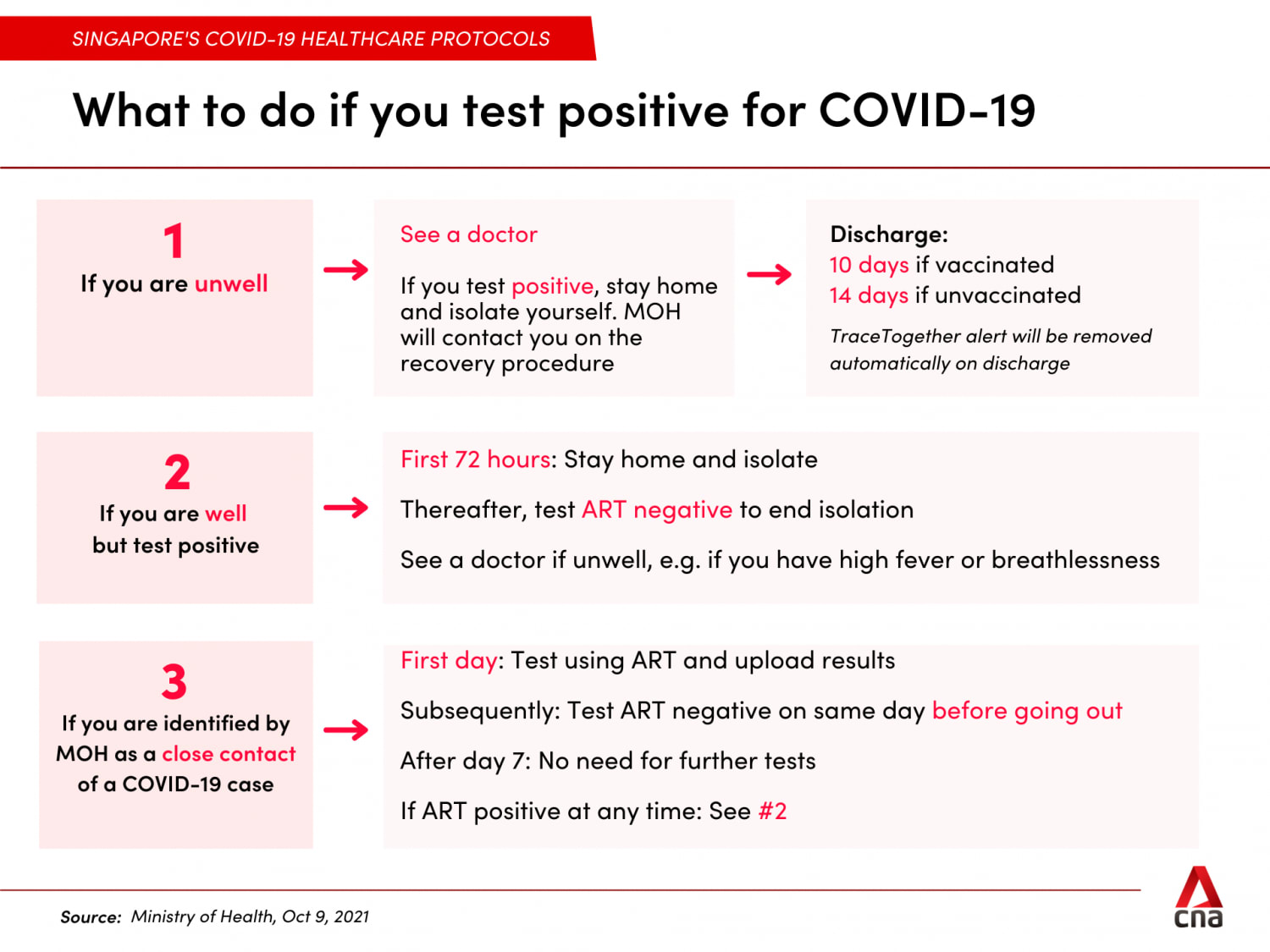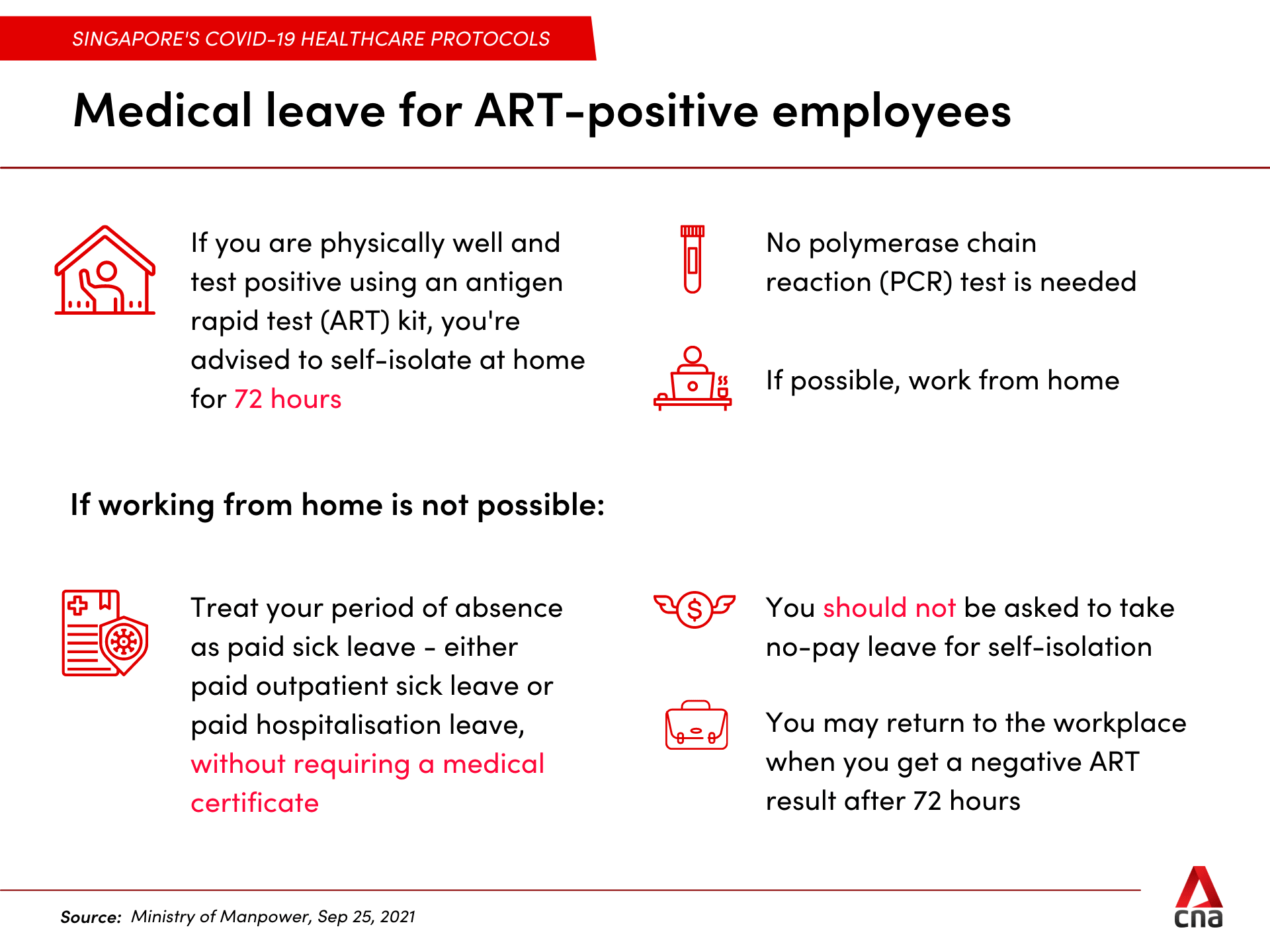No quarantine orders for close contacts of COVID-19 cases as MOH urges personal responsibility
SINGAPORE: Close contacts of COVID-19 cases will no longer receive quarantine orders and people testing for the disease can follow one of three steps, under simplified healthcare protocols announced by the Ministry of Health (MOH) on Saturday (Oct 9).
The revised protocols that will take effect on Oct 11 "mark a shift in emphasis towards personal responsibility and self-management", MOH said.
Protocols for those who are unwell and test positive for COVID-19 will also change – they will be diagnosed using an antigen rapid test (ART) instead of a polymerase chain reaction (PCR) test that is currently the default. They will also be discharged from isolation based on the number of days they have been isolated as opposed to a negative test.
Those who are well and test positive will also not need a PCR test, and will have to stay isolated for as long as their tests show a positive reading beyond 72 hours.

At a press conference by the COVID-19 multi-ministry task force, Health Minister Ong Ye Kung said that the Delta variant, which is more infectious and has higher viral loads than previous variants, has changed the country's risk calculation.
"ART, including a self-swab, does a pretty good job at detecting someone who has been infected and is infectious, and that makes ART more useful now than before in terms of detecting COVID-19 patients," he said.
The changes come as the authorities press a “reset button” with the “huge effort” to simplify rules that have been accumulated over 20 months, MOH said.
It’s a “significant simplification” of what is currently in place, it added.
"Some people tell me they are more afraid of these rules than COVID-19 itself and this is a sentiment and a problem that needs to be addressed," Mr Ong said.
CLOSE CONTACTS OF COVID-19 PATIENTS
Close contacts of COVID-19 patients will be given health risk warnings, in a move away from “prolonged quarantine orders”, MOH said. They will need to perform an ART on the first day and upload the results on a portal, MOH said.
On subsequent days, if they are going out, they must test negative with an ART on the same day. They do not need to test beyond the seventh day, as the period where there is most concern about being infected would have passed, MOH said.
"Previously, we differentiated contacts of COVID-19 cases into various risk levels and imposed several measures," it said. These measures included quarantine orders, health risk alerts and health risk warnings.
"There will now be a single approach – a health risk warning that lasts seven days from the day of its issuance, that is based on ART self-testing."
Mr Ong said that an ART at the beginning will catch the majority of close contacts who are already positive. Repeated ART testing can detect most of the rest, he added.
"A system like that is less watertight than today's quarantine system, but it can significantly and substantively manage the risk," he said.
As Singapore moves towards living with COVID-19, restricting large numbers of people every day over prolonged periods to weed out the "last tail risk" is "not sustainable", he said.
"(It is) in fact very frustrating and disruptive to many people and families," he said.
Those who receive health risk warnings can collect ART kits from vending machines, the number of which has doubled from 100 to 200, MOH said. Each health risk warning recipient will get six test kits. A total of 7.5 million kits have been allocated for this.
IF YOU ARE COVID-19 POSITIVE, WITH SYMPTOMS
Those who are unwell are encouraged to see a doctor who will assess them.
If the doctor assesses that there's a possibility that they might have a COVID-19 infection, then the person will be tested, MOH said.
The majority will go through an ART without a need for a PCR test and if found COVID-19 positive, patients will have to go home and start their isolation. The doctor will notify MOH, which in turn will contact the patient with further instructions on what to do.
Those who are fully vaccinated will have to isolate themselves for 10 days while the unvaccinated will have to isolate for 14 days. MOH said it has “relaxed” the requirement for those self-isolating to have an ensuite toilet and bathroom in the same room.
This will apply as long as people are able to clean the bathroom after it has been used so that other members of the household are not exposed to infection.
They will either be placed on the home recovery programme by default, or if the home environment is not suitable, they can recover at the appropriate care facilities, MOH said.
MOH representatives will call patients to ask them questions about who lives in their home and about their domestic situation.
That will provide a better understanding of the situation is so that advice can be given on whether it's safe to continue isolating at home, or whether arrangements should be made to provide accommodation at a community isolation facility, MOH said.
The majority are expected to be able to isolate themselves at home, the ministry added.
At the end of their isolation, their TraceTogether phone application will be automatically updated that they are "discharged".
IF YOU ARE COVID-19 POSITIVE, BUT NO SYMPTOMS
Those who are well and undergo ART for reasons such as pre-event testing will have to self-isolate for 72 hours and take another test at the end of that time.
Despite having to be isolated, these people may make a trip to a vending machine to get free ART kits, MOH said.
If found not to have COVID-19, people can end their isolation and resume their normal activities. For as long as the test shows a positive reading, however, the individual must isolate himself, MOH said.
If someone experiences symptoms such as high fever or breathlessness, the person should see a doctor, MOH said, adding that telemedicine services could be an option.
Employees diagnosed with COVID-19 through ART and are “physically well” can work from home if possible. If working from home is not possible, they will have to consume paid sick leave, but will not have to produce a medical certificate, MOH said.
They may return to their workplace when they get a negative ART result after 72 hours.

BOOKMARK THIS: Our comprehensive coverage of the COVID-19 pandemic and its developments
Download our app or subscribe to our Telegram channel for the latest updates on the coronavirus pandemic: https://cna.asia/telegram










